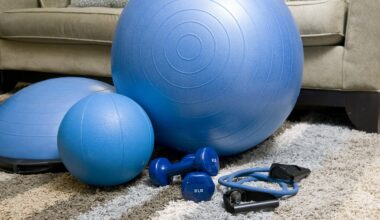Cross-Training Tips for Open Water Swimmers
Open water swimming presents unique challenges and rewards you won’t find in the pool. To prepare for these, incorporating cross-training can elevate your performance and endurance in the water. Various activities can enhance your swimming capabilities by building strength, endurance, and flexibility. For instance, consider activities like cycling and running, which engage your cardiovascular system and improve aerobic capacity. Additionally, practices such as yoga or Pilates can significantly aid in enhancing flexibility and core strength, crucial attributes for efficient swimming. Transitioning from pool to open water requires adapting to diverse environmental conditions, which means varied training is essential. Cross-training not only fosters physical adaptations but also mental resilience, allowing you to face uncharted waters confidently. Lastly, maintaining a balanced routine prevents injuries by ensuring that you’re not overusing specific muscle groups. Keep in mind that the ultimate goal of cross-training is to enhance your swimming performance, and it’s important to select activities that complement rather than detract from your swimming efforts. Embrace a variety of forms of exercise to keep your fitness routine engaging, ensuring motivation throughout your training sessions.
One effective way to implement cross-training into your regimen is to focus on strength training. Lifting weights or utilizing resistance bands can boost muscle power important for swimmers. Emphasizing the major muscle groups engaged in swimming, specifically the core, back, and shoulders, creates the right conditions for progress. A solid strength training program should include exercises like bench presses, rows, squats, and deadlifts. Not only do these movements strengthen the necessary muscles, but they also enhance overall body coordination, vital for smooth swimming strokes. Furthermore, practicing specific functional movements can translate directly into improved performance in the water. Another great addition is incorporating agility drills, which can increase your overall speed and responsiveness in open water situations. For instance, ladder drills or cone drills can enhance your foot speed and coordination. The goal is to enhance not just your strength but also your overall functional fitness for swimming. Remember, incorporating these strength and agility components 1-2 times a week is optimal to see benefits without overtraining. Always listen to your body, adjust as necessary, and ensure recovery time is factored into your training.
Swimming-Specific Drills
Incorporating swimming-specific drills during your cross-training can enhance your swimming efficiency, stroke mechanics, and adaptability. Dryland training exercises focusing on specific swimming movements, such as resistance bands mimicking stroke patterns, develop muscular strength and neuromuscular coordination. These activities allow you to practice technique without actually being in the water, making it a great complement to regular swimming workouts. Techniques such as using a medicine ball for rotational exercises can mimic the twisting movements experienced during strokes. Additionally, engaging in swim cords can provide variable resistance to build strength specific to swimming. Furthermore, performing core stability exercises along with hip mobility drills directly contributes to stronger swimming performance. Resistance training targeting the lats and triceps helps swimmers develop stronger pulls through the water. Also, don’t overlook the value of functional balance activities that can improve your floating and buoyancy skills. Incorporating a variety of drills will keep your training fresh and engaging, making substantial improvements in your open water performance. Aim for consistency and make these drills a prominent part of your weekly training schedule to foster overall development.
Cardio workouts serve as another crucial aspect of cross-training for open water swimmers. Building your cardiovascular endurance is essential for long-distance swims in unpredictable conditions. Activities such as running, cycling, and rowing can effectively enhance your aerobic capacity. Aim to dedicate at least two to three sessions weekly to these workouts, focusing on varying intensity levels to build stamina. High-Intensity Interval Training (HIIT) sessions can be particularly beneficial, as they boost heart rate and simulate the demands of open water swimming. Additionally, incorporating longer, steady-state cardio sessions is vital for building the endurance needed for extended swims. Not only does cardiovascular training improve physical fitness, but it also helps to develop mental toughness, allowing swimmers to push through challenging conditions. Remember to combine these cardiovascular workouts with your swimming routines to ensure a balanced training plan. Implementing these types of sessions will prepare you to tackle the numerous challenges you might encounter in open water environments, such as waves and currents. A comprehensive training program that emphasizes overall fitness will yield the best results on race day.
Flexibility and Mobility Work
Incorporating flexibility and mobility work into your cross-training routine is paramount for open water swimmers. Improved flexibility contributes to better body positioning and stroke efficiency, which are critical when swimming in open water. Yoga, dynamic stretching, and specific mobility drills for swimmers can play a vital role in enhancing your range of motion. Spend at least 10-15 minutes daily focusing on key muscle areas, particularly hips, shoulders, and back. This not only increases flexibility but also prevents injuries, a common concern for swimmers engaged in high-intensity training. Specific movements like the downward dog, butterfly stretch, and shoulder dislocates are excellent for developing necessary mobility. Implementing foam rolling techniques targeting tight areas will additionally assist in recovery and flexibility improvement. Furthermore, understand that having a strong range of motion helps optimize stroke mechanics, making your swim smoother and more efficient. Dedicate time each week to assess your flexibility, adjusting your workouts as needed to continue improving. Thus, ensure a well-rounded approach to cross-training prioritizes these critical aspects, which can significantly impact your performances in open water venues.
Swimming in open water means confronting environmental factors like waves, currents, and temperature variations. Therefore, it’s beneficial to practice in various real-world conditions to adapt and improve your comfort level. If possible, schedule regular open water swim sessions in addition to your training regimen. This will familiarize you with different swimming environments, enhancing your skills to manage different terrains effectively. It might also be helpful to team up with others for open water training, allowing for motivation, safety, and competitive elements. Practicing sighting and navigation techniques during these sessions will particularly benefit your ability to stay on course, a necessary skill during races. Work on your pacing strategies by engaging in interval training targeted toward race conditions. Take note of how you feel in varying conditions, refining your approach gradually. Embrace changes in weather and temperature, using them to your advantage. Understanding how factors influence your performance is key to progress. Moreover, building this adaptability will increase confidence, reflecting well on race day. Offering diverse training opportunities related to open water conditions will substantially prepare you for any potential challenges.
Nutrition for Cross-Training
Lastly, don’t underestimate the importance of proper nutrition when engaging in cross-training for open water swimming. Fueling your body with the right nutrients is essential for maintaining energy levels and aiding recovery. Focus on consuming a balanced diet rich in carbohydrates, healthy fats, and proteins to support your training needs. Hydration is equally crucial—ensure adequate fluid intake, especially before and after workouts to facilitate optimal performance. Incorporating a variety of fruits and vegetables will provide essential vitamins, minerals, and antioxidants that support overall well-being. Pay attention to your meal timing; larger meals should be eaten a few hours prior to training, while smaller snacks can be enjoyed closer to your workout. Post-exercise nutrition should focus on recovery, containing proteins and carbohydrates to help with muscle repair. Additionally, experiment with energy gels or bars on longer training days to understand what works best for your body during durations similar to race events. Making well-informed nutritional choices will significantly affect your training performance and overall success in open water swimming.
This concludes our exploration of cross-training tips specifically designed for open water swimmers. Armed with these strategies, you can develop a holistic training approach that enhances performance and prepares you for the challenges ahead. Ensuring a mixture of strength training, cardiovascular endurance, flexibility work, and nutrition management is key. To summarize, strength training will build muscle and power; cardio will foster endurance and resilience; flexibility workouts will improve your mechanics; and nutrition will fuel your activities effectively. As you continue on your journey, always monitor your progress and adjust your training as needed, recognizing the inherent differences between pool swimming and open water conditions. Adaptability and preparation are crucial aspects that will help you thrive during your swims. Creating a routine that allows for open water practice will further solidify your skills, ensuring confidence in every stroke you take. The journey doesn’t end here; commitment, training, and a passion for swimming will lead to success. So, embrace these cross-training methods, invest the time and effort, and prepare to improve both your skills in the water and your enjoyment of what you love: swimming.


